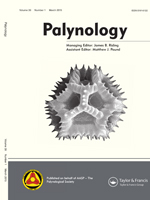Palynostratigraphy across the Permian—Triassic of the Salt Range and Surghar Range area remains poorly known because of the predominance of unsuitable facies and preservation (Nammal, Chhidru, Chitta-Landu and Narmia). Dolomite and limestone in the basal Mianwali Formation prevented the establishment of a palynostratigraphic scheme for the basal Early Triassic (Hermann et al. 2012). Based on the study of a new Permian—Triassic section in the Amb valley where siltstone layers are intercalated in the basal Mianwali Formation (Kathwai Member), we describe a new record of palynological assemblages from the uppermost Permian Chhidru Formation and the lowermost part of the Early Triassic Mianwali Formation. The latest Permian Chhidru 2 sporomorph association occurs in the uppermost part of the Chhidru Formation, the so-called ‘white sandstone unit’. It is marked by the dominance of bisaccate pollen grains (mainly Protohaploxypinus spp.) and cavate trilete spores (mainly Kraeuselisporites spp.). Here, the previously described lowermost Triassic palynozone PTr 1 is subdivided into two subzones. PTr 1a assemblages are described from the Griesbachian Kathwai Member. They are characterized by continued high bisaccate pollen grain abundances and the presence of the lycopod genera Lundbladispora spp. and Densoisporites spp. In these assemblages, typical ‘Permian taxa’ and typical ‘Triassic taxa’ are mixed. The composition of the middle Dienerian PTr 1b assemblages corresponds to the previously described PTr 1 assemblage from Nammal and Chitta-Landu. Lundbladispora spp. and Densoisporites spp. account for ca. 80% of the total assemblage in PTr 1b. Although the Griesbachian assemblages record a decrease in diversity, the middle Dienerian assemblages represent the poorest assemblages of the studied Permian—Triassic interval. Reduviasporonites occurs only sporadically throughout the Amb succession.
How to translate text using browser tools
1 June 2015
Palynostratigraphy at the Permian—Triassic Boundary of the Amb Section, Salt Range, Pakistan
Elke Schneebeli-Hermann,
Hugo Bucher
ACCESS THE FULL ARTICLE
It is not available for individual sale.
This article is only available to subscribers.
It is not available for individual sale.
It is not available for individual sale.

Palynology
Vol. 39 • No. 1
June 2015
Vol. 39 • No. 1
June 2015
extinction
Pakistan
palynostratigraphy
Permian—Triassic boundary




